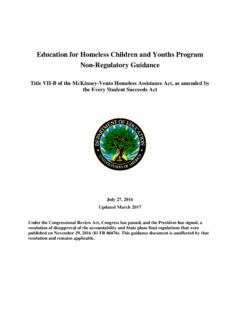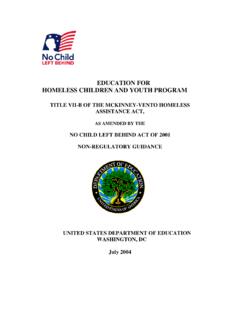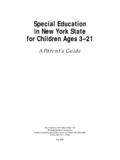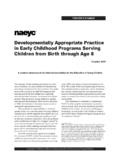Transcription of Professional Practices in Children’s Museums
1 Standards for Professional Practice in children 's Museums Reproduction without permission prohibited 1992, 2012. children 'S Museums WHERE children LEARN THROUGH PLAY AND EXPLORATION. IN ENVIRONMENTS AND EXPRIENCES DESIGNED JUST FOR THEM. [ii]. What are children 's Museums ? children 's Museums are a pioneering and dynamic group of institutions that are challenging and redefining the boundaries of the traditional museum world and are always reimaging themselves. children 's Museums emphasize the educational role of Museums , the visitor ( children and families), contextual interactive exhibit strategies and programs over the more traditional museum focus on the preservation/research role, permanent collections, and non-tactile display or presentation of objects. In children 's Museums , the needs and interests of the audience, the motivation to learn, and empowerment of the visitor through contact and direct experience with objects are as important as subject or content focus.
2 CONTENTS. I. Standards for Professional Practice 1. Definitions Page 1. 2. Mission/Planning Page 2. 3. Exhibits and programs Page 3. Object Use Page 5. 4. Public Dimension Page 6. II. Self-Study Questionnaire 1. Mission/Planning Page 7. 2. Exhibits and programs Page 7. Object Use Page 8. 3. Public Dimension Page 9. children 's Museums Standards Document Association of children 's Museums . [iii]. HOW SHOULD THIS GUIDE BE USED? This document attempts to identify the needs and concerns of children 's Museums and to avoid replication of standards commonly accepted as applying to the museum field as a whole. Therefore, it is the intent of ACM to encourage the use of other publications as companion documents and references. All children 's Museums should be familiar with the following : 1. American Alliance of Museums Core Standards for Museums and Accreditation Self-Study - The criteria by which a museum should be operating are stated in the standards and inherent in the Self- Study questions.
3 2. Community Engagement Assessment - The community engagement self-study of the AAM Museum Assessment Program focuses on the public dimension of a museum. 3. Excellence and Equity: Education and the Public Dimension of Museums - The report by the AAM. Task Force on Museum Education presents an expanded definition of the educational role of Museums . Available through American Alliance of Museums , 1575 I Street NW, Suite 400, Washington, DC 20005;. (202) 289-1818. Using the Standards The standards outlined in this document are intended for use in several ways: As an educational tool for children 's Museums that are in the planning stages or newly opened so that they are aware of Professional expectations commonly accepted by the children 's museum field. As a guide for children 's Museums that are in operation and are striving to achieve higher levels of professionalism; the guide will be useful in long range planning processes and in staff and board orientation to the field of children 's Museums .
4 As a benchmark for children 's Museums that are seeking accreditation from the American Association of Museums . These standards will be used by AAM visiting committees to help them evaluate the levels of professionalism found in the applicant museum. History of the Standards The standards and self-study were developed by the Association of children 's Museums Self-Study Task Force with broad involvement from its members. The project was supported by a grant from the Institute of Museum and Library Services. children 's Museums Standards Document Association of children 's Museums . [1]. DEFINITIONS. children 's Museum: A children 's museum is defined as an institution committed to serving the needs and interests of children by providing exhibits and programs that stimulate curiosity and motivate learning. children 's Museums are organized as permanent non-profit institutions1, essentially educational in purpose, with Professional staff, which utilize objects and are open to the public on some regular schedule.
5 Collections: Objects, living or nonliving, that Museums hold in trust for the public. Items usually are considered part of the museum's collections once they are accessioned. Some Museums designate different categories of collections (permanent, research, educational) that functionally receive different types of care or use. These categories and their ramifications are established in the museum's collections management policy. Collections Management Policy: A collections management policy is a written document, approved by the governing authority, which specifies the museum's policies concerning all collections-related issues, including accessioning, documentation, storage, and disposition. Policies are general guidelines that regulate the activities of the organization. They provide standards for exercising good judgment. Object: As defined for children 's Museums , objects primarily serve as tools to motivate learning and address the developmental needs of children .
6 They are instruments for carrying out the children 's museum's educational objectives, and reflect these purposes. The mode of presentation is substantially interactive and contextual. Objects may not necessarily have intrinsic value to science, history, art, or culture, and can include constructed activity pieces and exhibit components. 1. Non-profit status applies to Museums . children 's Museums Standards Document Association of children 's Museums . [2]. MISSION/PLANNING. The mission statement defines the purpose of the museum and the means by which it achieves its purpose (what it will and will not do as an institution). A strong, clear, concise mission statement is important in creating a foundation for a shared vision for the museum and in setting the stage for effective leadership of the institution2. As a museum evolves as an institution the mission statement will evolve also. A strategic plan is critical to any museum as a guide to future institutional development but especially for children 's Museums given the rapid rate at which these Museums tend to grow and expand.
7 A strategic plan establishes the desired direction and goals of the museum, assesses needs and resources (present and potential), and sets forth strategies to achieve goals. Strategic plans commonly address a three to five year time span with provisions for regular updates (such as on an annual basis). Standards for Professional Practice 1. The mission statement is a written document that has been formally approved by the board of trustees or governing body. It is in accord with the purposes of the museum as set forth in the museum's charter, articles of incorporation/bylaws, or other legal documents. 2. The mission statement is reviewed periodically and revised when necessary. 3. All museum activities are measured against its mission statement. Policies, programs , exhibits, and collections are evaluated against the mission. 4. A mission statement specifies children as the audience (and associated audiences as appropriate). since this is a major distinguishing characteristic of the field.
8 It can delineate the visitor age group that the museum targets since this will determine or impact the focus of the museum and the expertise needed to appropriately serve them, , ages 2-12, or the inclusion of adolescents. Because of the wide diversity of children 's Museums , it is helpful to know the content or disciplines that the museum focuses on in order to get a full picture of the museum's activities; some children 's Museums specialize in art, science, etc., while others are generalist and address a variety of subjects. 5. The museum has a strategic plan with metrics to guide the future direction of the museum and the plan is formally approved by the Board. 6. The museum has a philosophical framework or written core values encompassing its beliefs about education and learning theories and methods for stimulating curiosity and learning for children . The framework is used to determine appropriate exhibit and program content, design and format.
9 2. Sample mission statements are included in the Collective Vision toolkit available on the ACM Web site. children 's Museums Standards Document Association of children 's Museums . [3]. EXHIBITS AND programs . Exhibits and programs children 's Museums are audience-based and reflect their communities, always striving to identify and meet community needs. Therefore, each children 's museum is unique and community specific. This uniqueness results from a collaborative process with community groups. Not every exhibit or program will be unique since there are many existing exhibits and program models that are effective and are found in many children 's Museums because they do work. All children 's Museums place an emphasis on interactive and experiential exhibit strategies, but each develops its own character and identity as it grows and matures. children 's Museums have a strong internal commitment to teamwork, especially in the development and design of exhibits.
10 Commonly the approach to exhibit development involves team coordination of staff representatives with expertise in areas of educational/child development theory, content/discipline specialties and exhibit design. The team draws on other staff capabilities and outside resources as appropriate and utilizes some form of visitor input. children 's Museums rely heavily on floor staff and volunteers to interface directly with visitors in exhibits and programs . Research indicates the importance of facilitation, mediated learning, and apprenticeships in supporting informal learning. children 's Museums are labor intensive institutions because the application of these findings requires a substantial commitment of human resources. Training for staff and volunteers is critical to effectively enhance the play and learning experience for the visitor. Evaluation is a necessary component for enhancing the effectiveness and assessing the success of a museum's exhibits and programs and is given as high a priority as resources will allow.






